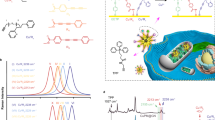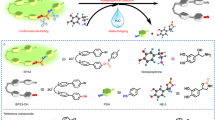Abstract
Nitric oxide (NO) serves as a messenger for cellular signaling. To visualize NO in living cells, we synthesized a turn-on fluorescent probe for use in combination with microscopy. Unlike existing fluorescent sensors, the construct—a Cu(II) complex of a fluorescein modified with an appended metal-chelating ligand (FL)—directly and immediately images NO rather than a derivative reactive nitrogen species. Using spectroscopic and mass spectrometric methods, we established that the mechanism of the reaction responsible for the NO-induced fluorescence involves reduction of the complex to Cu(I) with release of the nitrosated ligand, which occurs irreversibly. We detected NO produced by both constitutive and inducible NO synthases (cNOS and iNOS, respectively) in live neurons and macrophages in a concentration- and time-dependent manner by using the Cu(II)-based imaging agent. Both the sensitivity to nanomolar concentrations of NO and the spatiotemporal information provided by this complex demonstrate its value for numerous biological applications.
This is a preview of subscription content, access via your institution
Access options
Subscribe to this journal
Receive 12 print issues and online access
$259.00 per year
only $21.58 per issue
Buy this article
- Purchase on Springer Link
- Instant access to full article PDF
Prices may be subject to local taxes which are calculated during checkout





Similar content being viewed by others
References
Murad, F. Discovery of some of the biological effects of nitric oxide and its role in cell signaling. Angew. Chem. Int. Edn. Engl. 38, 1856–1868 (1999).
Furchgott, R.F. Endothelium-derived relaxing factor: discovery, early studies and identification as nitric oxide. Angew. Chem. Int. Edn. Engl. 38, 1870–1880 (1999).
Ignarro, L.J. Nitric oxide a unique endogenous signaling molecule in vascular biology. Angew. Chem. Int. Edn. Engl. 38, 1882–1892 (1999).
Packer, L. Methods in Enzymology, Nitric Oxide Part B, Physiological and Pathological Processes (Academic, San Diego, 1996).
Moncada, S., Palmer, R.M.J. & Higgs, E.A. Nitric oxide: physiology, pathphysiology, and pharmacology. Pharmacol. Rev. 43, 109–142 (1991).
Ricciardolo, F.L.M., Sterk, P.J., Gaston, B. & Folkerts, G. Nitric oxide in health and disease of the respiratory system. Physiol. Rev. 84, 731–765 (2004).
Conner, E.M. & Grisham, M.B. Nitric oxide: biochemistry, physiology, and pathophysiology. Methods Enzymol. 7, 3–13 (1995).
Hampl, V., Walters, C.L. & Archer, S.L. in Methods in Nitric Oxide Research (eds Feelisch, M. & Stamler, J.S.) 309–318 (John Wiley & Sons, New York, 1996).
Nagano, T. & Yoshimura, T. Bioimaging of nitric oxide. Chem. Rev. 102, 1235–1269 (2002).
Malinski, T., Mesaros, S. & Tomboulian, P. Nitric oxide measurement using electrochemical methods. Methods Enzymol. 268, 58–69 (1996).
Hilderbrand, S.A., Lim, M.H. & Lippard, S.J. in Topics in Fluorescence Spectroscopy (eds. Geddes, C.D. & Lakowicz, J.R.) 163–188 (Springer, Berlin, 2005).
Sato, M., Hida, N. & Umezawa, Y. Imaging the nanomolar range of nitric oxide with an amplifier-coupled fluorescent indicator in living cells. Proc. Natl. Acad. Sci. USA 102, 14515–14520 (2005).
Miles, A.M., Chen, Y., Owens, M.W. & Grisham, M.B. Fluorometric determination of nitric oxide. Methods Enzymol. 7, 40–47 (1995).
Sasaki, E. et al. Highly sensitive near-infrared fluorescent probes for nitric oxide and their application to isolated organs. J. Am. Chem. Soc. 127, 3684–3685 (2005).
Wink, D.A., Grisham, M.B., Mitchell, J.B. & Ford, P.C. Direct and indirect effects of nitric oxide in chemical reactions relevant to biology. Methods Enzymol. 268, 12–31 (1996).
Lozinsky, E.M. et al. Detection of nitric oxide from pig trachea by a fluorescence method. Anal. Biochem. 326, 139–145 (2004).
Nolan, E.M., Burdette, S.C., Harvey, J.H., Hilderbrand, S.A. & Lippard, S.J. Synthesis and characterization of zinc sensors based on a monosubstituted fluorescein platform. Inorg. Chem. 43, 2624–2635 (2004).
Sjöback, R., Nygren, J. & Kubista, M. Absorption and fluorescence properties of fluorescein. Spectrochim. Acta A Mol. Biomol. Spectrosc. 51, L7–L21 (1995).
Bonnett, R., Holleyhead, R., Johnson, B.L. & Randall, E.W. Reaction of acidified nitrite solutions with peptide derivatives: Evidence for nitrosamine and thionitrite formation from 15N n. m. r. studies. J. Chem. Soc. Perkin I 22, 2261–2264 (1975).
Karaghiosoff, K. et al. N-Nitroso- and N-nitraminotetrazoles. J. Org. Chem. 71, 1295–1305 (2006).
Lee, J., Chen, L., West, A.H. & Richter-Addo, G.B. Interactions of organic nitroso compunds with metals. Chem. Rev. 102, 1019–1066 (2002).
Tsuge, K., DeRosa, F., Lim, M.D. & Ford, P.C. Intramolecular reductive nitrosylation: reaction of nitric oxide and a copper(II) complex of a cyclam derivative with pendant luminescent chromophores. J. Am. Chem. Soc. 126, 6564–6565 (2004).
Lim, M.H. & Lippard, S.J. Copper complexes for fluorescence-based NO detection in aqueous solution. J. Am. Chem. Soc. 127, 12170–12171 (2005).
Smith, R.C., Tennyson, A.G., Lim, M.H. & Lippard, S.J. Conjugated polymer-based fluorescence turn-on sensor for nitric oxide. Org. Lett. 7, 3573–3575 (2005).
Xia, Y. & Krukoff, T.L. Estrogen induces nitric oxide production via activation of constitutive nitric oxide synthases in human neuroblastoma cells. Endocrinology 145, 4550–4557 (2004).
Marletta, M.A., Hurshman, A.R. & Rusche, K.M. Catalysis of nitric oxide synthase. Curr. Opin. Chem. Biol. 2, 656–663 (1998).
Wang, D. & Lippard, S.J. Cisplatin-induced post-translational modification of histones H3 and H4. J. Biol. Chem. 279, 20622–20625 (2004).
Miwa, M., Stuehr, D.J., Marletta, M.A., Wishnok, J.S. & Tannenbaum, S.R. Nitrosation of amines by stimulated macrophages. Carcinogenesis 8, 955–958 (1987).
Ralt, D., Wishnok, J.S., Fitts, R. & Tannenbaum, S.R. Bacterial catalysis of nitrosation: involvement of the nar Operon of Escherichia coli. J. Bacteriol. 170, 359–364 (1988).
Ji, X.-B. & Hollocher, T.C. Mechanism for nitrosation of 2,3-diaminonaphthalene by Escherichia coli: Enzymatic production of NO followed by O2-dependent chemical nitrosation. Appl. Environ. Microbiol. 54, 1791–1794 (1988).
Nakatsubo, N. et al. Direct evidence of nitric oxide production from bovine aortic endothelial cells using new fluorescence indicators: diaminofluoresceins. FEBS Lett. 427, 263–266 (1998).
Lijinsky, W. Chemistry and Biology of N-nitroso Compounds (eds. Coombs M.M., Ashby, J. & Hicks, M.) (Cambridge University Press, Cambridge, UK, 1992).
Koppenol, W.H. Thermodynamics of reactions involving nitrogen-oxygen compounds. Methods Enzymol. 268, 7–12 (1996).
Ford, P.C. & Lorkovic, I.M. Mechanistic aspects of the reactions of nitric oxide with transition-metal complexes. Chem. Rev. 102, 993–1017 (2002).
Acknowledgements
This work was supported by grant CHE-0234951 from the US National Science Foundation (NSF). Spectroscopic instrumentation at the Massachusetts Institute of Technology Department of Chemistry Instrumentation Facility is maintained with funding from US National Institutes of Health Grant 1S10RR13886-01 and NSF Grants CHE-9808063, DBI9729592 and CHE-9808061. M.H. Lim thanks the Martin Family Society at the Massachusetts Institute of Technology for partial fellowship support. We thank A.Y. Ting and C.-W. Lin for assistance with epifluorescence microscopy, D.G. Nocera, D. Song and E.M. Nolan for helpful discussions, and C.D. Novina and D.M. Dykxhoorn for a gift of plasmid pcDNA3.1-Zeo(–)-U6 used in the RNAi experiments.
Author information
Authors and Affiliations
Contributions
M.H.L. and S.J.L. initiated, designed and performed the project. The RNAi experiment was carried out by D.X.
Corresponding author
Ethics declarations
Competing interests
The authors declare no competing financial interests.
Rights and permissions
About this article
Cite this article
Lim, M., Xu, D. & Lippard, S. Visualization of nitric oxide in living cells by a copper-based fluorescent probe. Nat Chem Biol 2, 375–380 (2006). https://doi.org/10.1038/nchembio794
Received:
Accepted:
Published:
Issue Date:
DOI: https://doi.org/10.1038/nchembio794
This article is cited by
-
Combining nitric oxide and calcium sensing for the detection of endothelial dysfunction
Communications Chemistry (2023)
-
A DNA-based fluorescent probe maps NOS3 activity with subcellular spatial resolution
Nature Chemical Biology (2020)
-
Nitric oxide production is involved in maintaining energy state in Alfalfa (Medicago sativa L.) nodulated roots under both salinity and flooding
Planta (2020)
-
Prediction method of CO2 production from electrical resistance of bread dough measured with a simple electrical multimeter in fermentation
Food Science and Biotechnology (2020)
-
Iridium-based probe for luminescent nitric oxide monitoring in live cells
Scientific Reports (2018)



